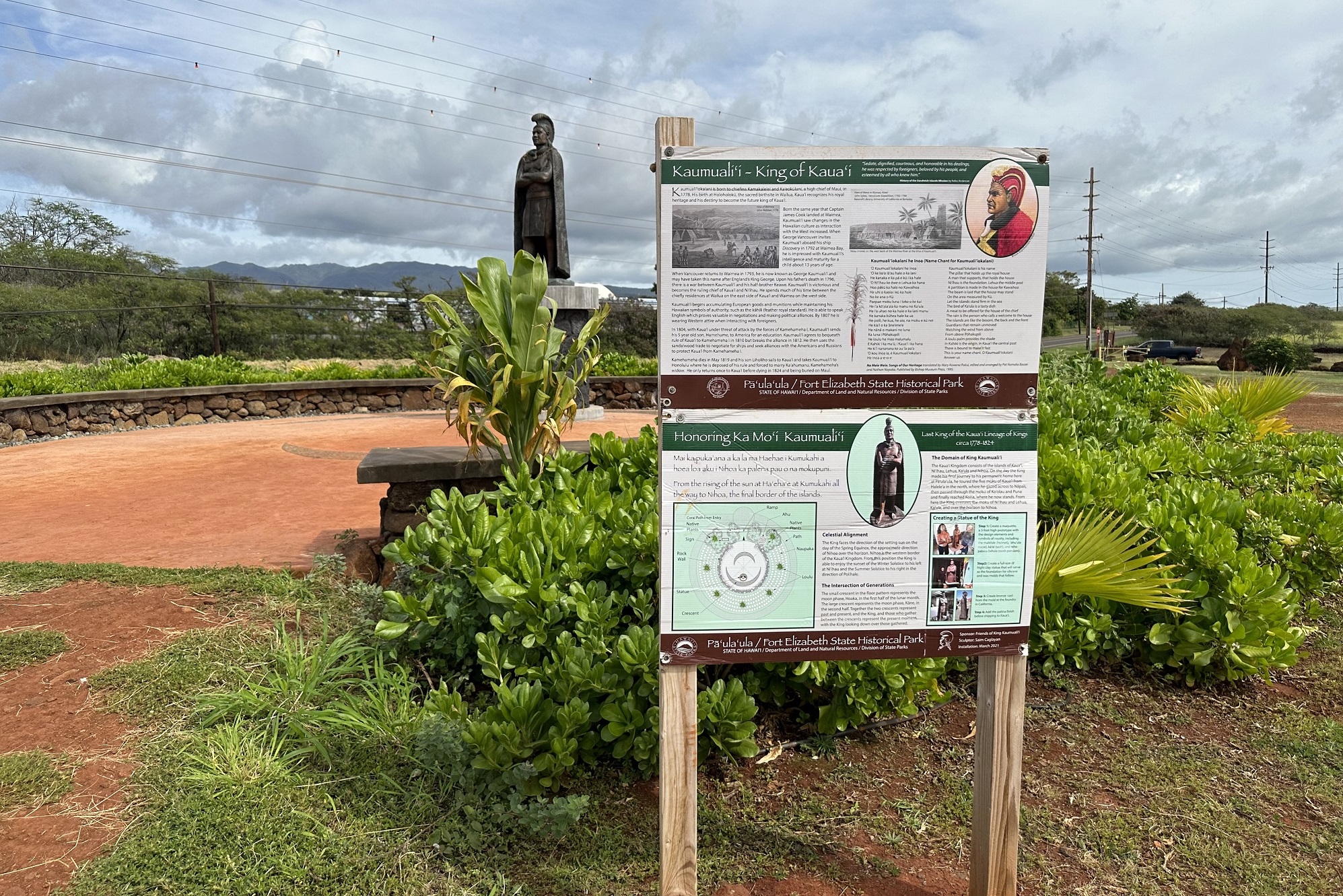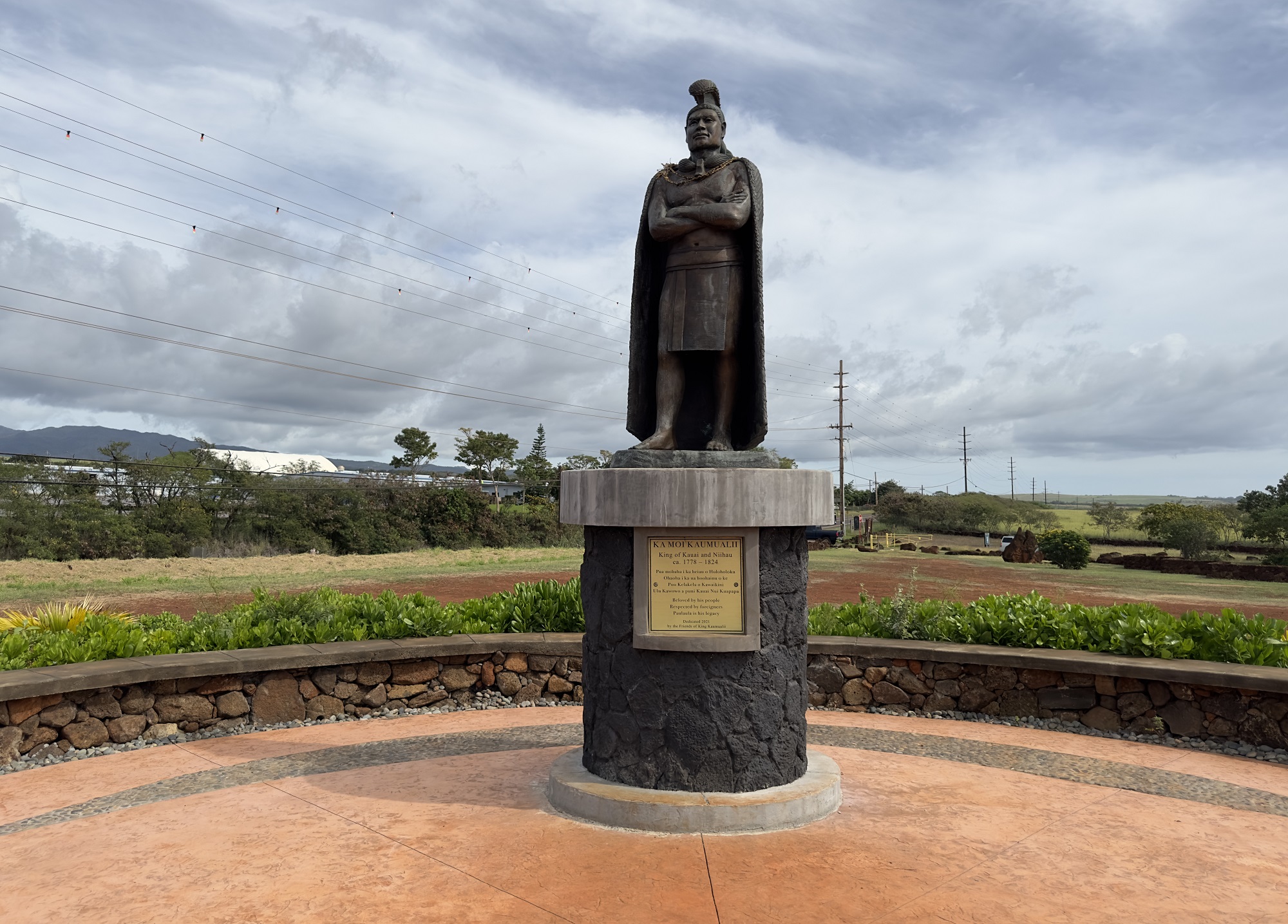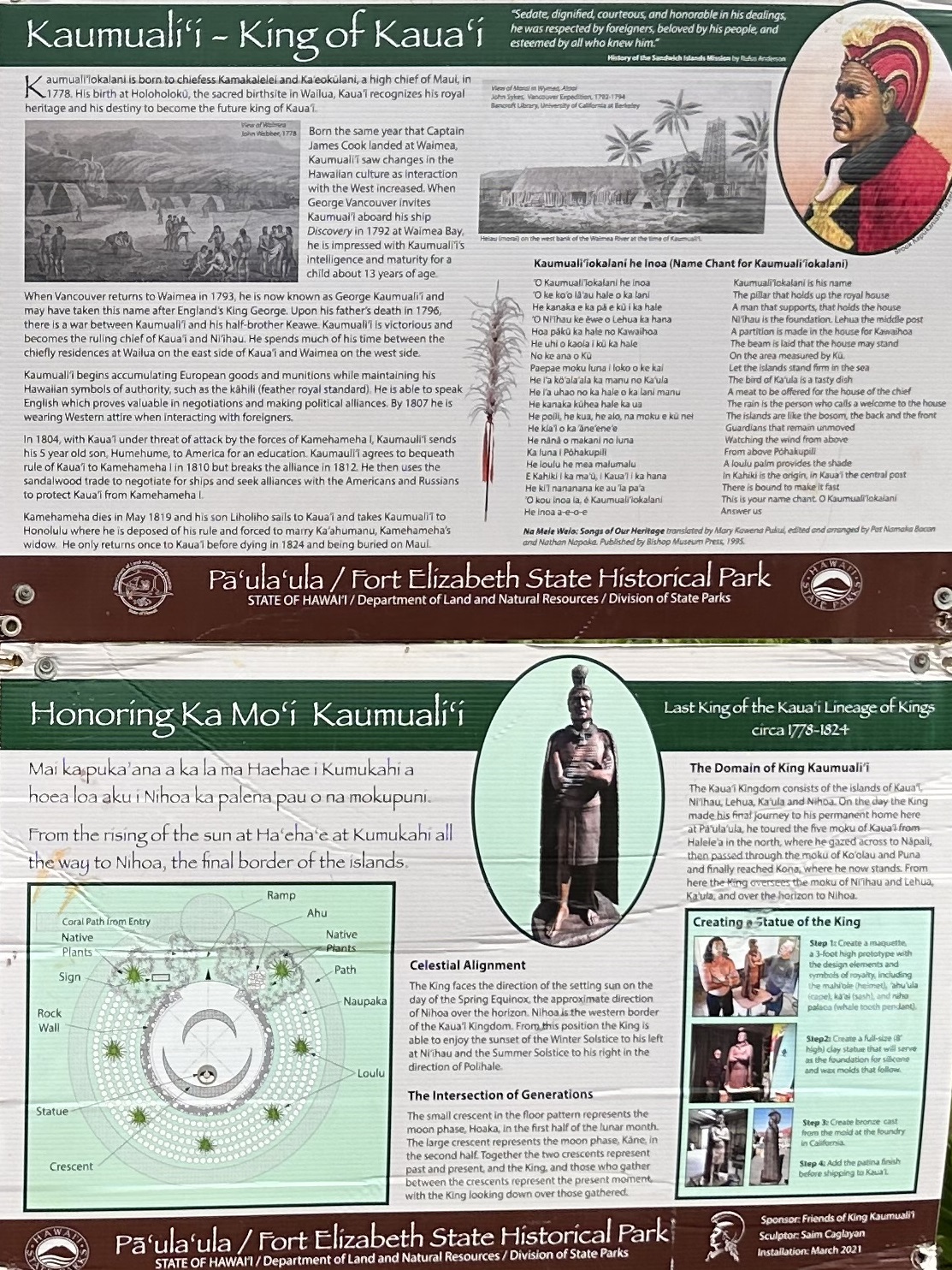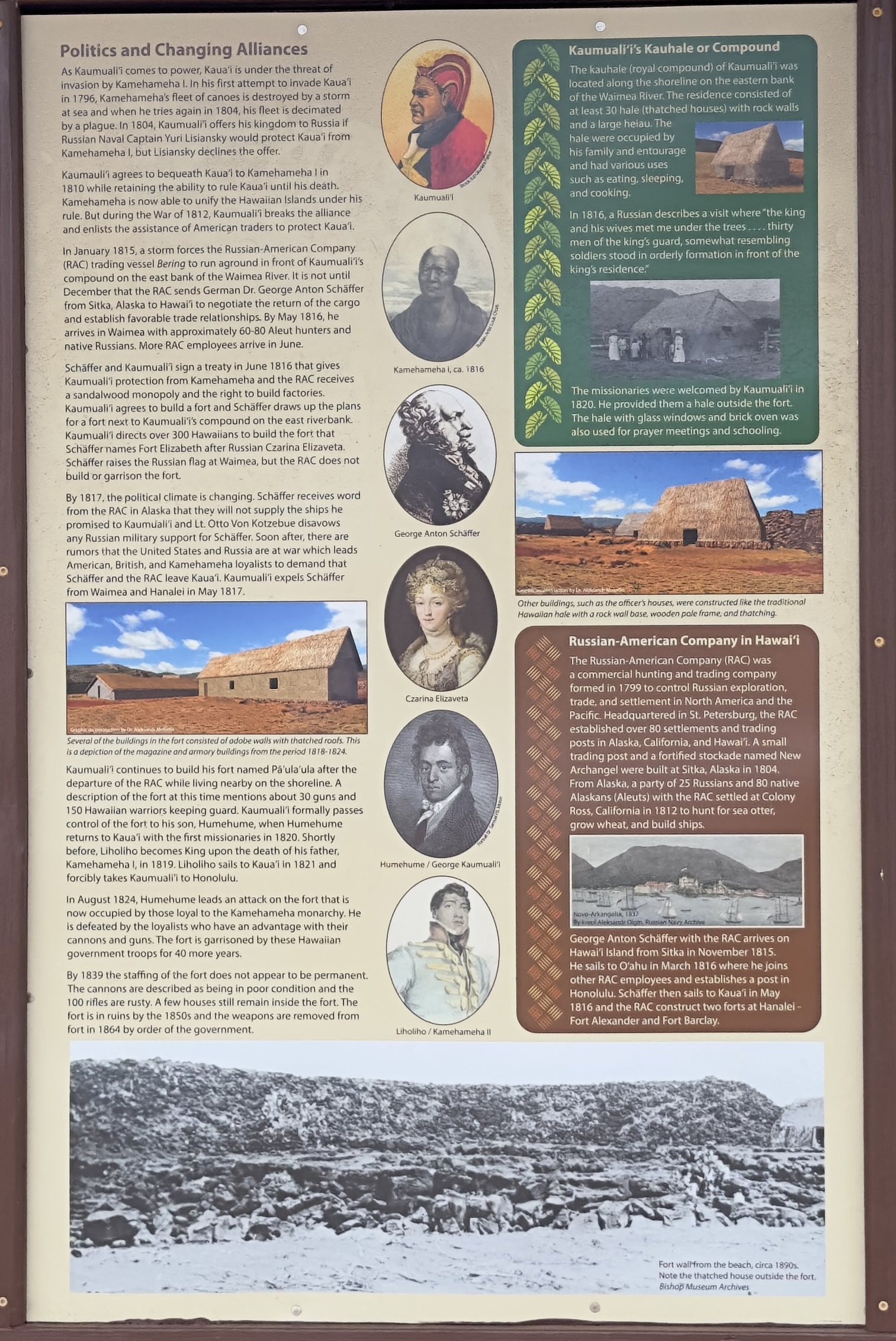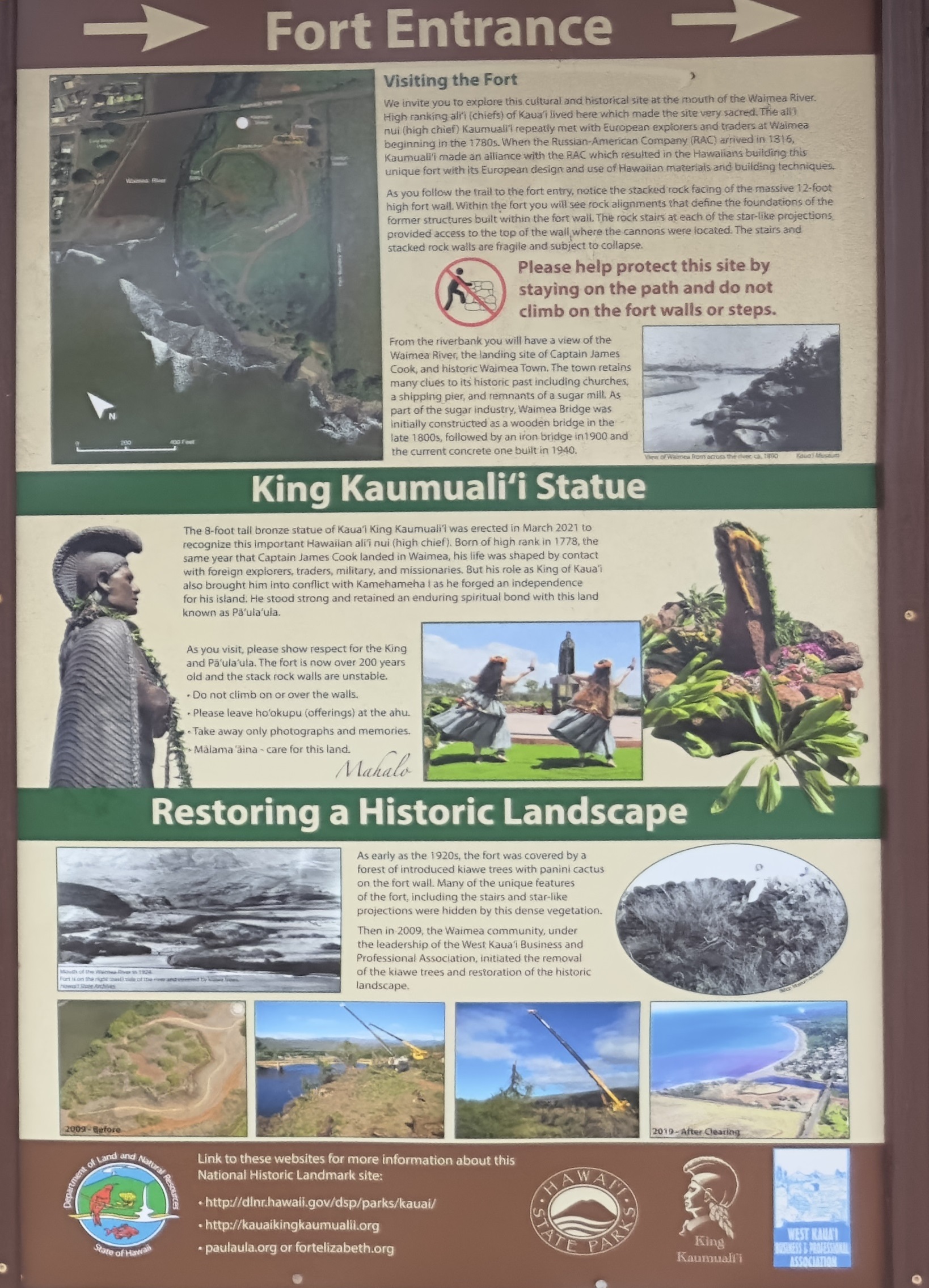The Russian Fort Elizabeth is a historical landmark that was partially built in 1817 by the Russian-American Company (RAC) on the banks of the Waimea River on Kauai. (The fort was later completed by Hawaiians after the Russians left.) The fort initiative by RAC was a short-lived attempt by the company to assert Russian influence over the Hawaiian islands and to trade for food and other items for their Alaskan and Californian ventures.
The name “Pāʻulaʻula” derives from the Hawaiian language and translates to “red-brown earth.” Kauai, and especially the area of Waimea, is known for its red-brown dirt.
Until recently, the site was known simply as the Russian Fort Elizabeth. In 2022 the park was rebranded as the Pāʻulaʻula State Historic Site to more accurately represent the historical significance of the site and emphasize its role in Native Hawaiian history. As part of the transformation of the site, a large statue of Kaumuali’i, the last independent king of Kauai and Niihau, and a central figure in the history of the fort, was added in 2021.
Fort Elisabeth History
In January of 1815, a storm forced the Russian-American Company (RAC) trading ship Bering to run aground near Kaumuali’i’s compound on the Waimea River. The company sent a German, Dr. George Anton Schaffer from Sitka, Alaska, to negotiate the return of the ship’s goods and to establish favorable trade relations. In June 1816, Shaffer and Kaumuali’i signed a treaty that resulted in the building of the fort. The treaty provided Kaumuali’i Russian protection from Kamehameha (a rival ruler of Hawaii), and in return, RAC received a monopoly position in the sandalwood trade and permission to build factories. As part of the agreement, Kaumuali’i agreed to the building of a fort on a strategic position overlooking the mouth of the Waimea River. However, by 1817, Russian support did not materialize and Kaumuali’i expelled Schaffer and the Russian-American Company before the fort was completed.
Schaffer designed the octagonal fort, and Kaumuali’i directed over 300 Hawaiians in the construction. The fort was built with a combination of Russian and Hawaiian methods resulting in a structure with formidable 20-foot stone walls. (The walls have crumbled over the years and are not nearly as tall.) A tunnel, that has since been filled in, was built from the shoreline to the fort to provide secure movement of goods.
The fort was not even half-finished by the time the Russians were expelled. Only the seaward wall had been completed along with a building and cellar that housed ammunition. After the departure of the Russians, Kaumuali’i finished the fort and it was occupied mostly by Hawaiians, first by people loyal to Kaumuali’i, then by people loyal to Kamehameha, and then by people loyal to other Hawaiian rulers over the course of the next 40 years. In retrospect, the Russian-American Company had just a brief (yet initially important) role in the fort’s overall history.
By the 1850-60s, the fort had fallen into disuse and disrepair and by the 1920s the structure had been completely abandoned and overgrown with kiawe trees and panini cactus.
In 1970, the fort became a Hawaii State Park. In 2009, the Waimea community came together under the leadership of the West Kauai Business and Professional Association to clear the fort of vegetation and restore the historical landscape.
King Kaumuali’i Statue
“Sedate, dignified, courteous and honorable in his dealings, he was respected by foreigners, beloved by his people, and esteemed by all who knew him.” – Rufus Anderson, History of the mission of the American Board of Commissioners for Foreign…
The 8-foot tall bronze statue of Kauai King Kaumuali’i was erected in March 2021 to acknowledge the contributions of Kaumuali’i to Kauai’s rich cultural history. Born to Hawaiian royalty in the same year that Captain Cook landed in Waimea (the Western discovery of Hawaii), Kaumuali’i’s intellect, stature and ability to speak English were instrumental in relations between the people of Kauai and foreign powers.
Visiting Pāʻulaʻula State Historic Site
Address: Kaumualii Hwy, Waimea, HI 96796
Map: Google Maps
Hours: Open 24 hours daily (daylight visits recommended)
Admission: Free
Facilities: Parking lot, interpretative exhibits and basic restrooms.
Today, visitors can walk the 18-acre grounds of the historic Pāʻulaʻula park and explore the remnants of the fort’s thick stone walls. Visitors are urged to stay on established paths and off the rock walls of the fort, which are fragile and subject to collapse. The octagonal shape of the fort is not apparent from ground level, though angles in the walls are obvious. Inside the fort are rock alignments that outline the foundations of former buildings within the walled area.
A short walk towards the riverbank reveals the strategic location of the fort, along with a nice view of the Waimea River, Waimea Bridge and the town of Waimea. Sunsets are often spectacular on this coastal bluff.
The Kaumuali’i statue is also a point of interest at the park, and ho’okupu (offerings) are allowed at the ahu (statue).
Beyond the park, a visit to the the vibrant town of Waimea is recommended. Known for its warm hospitality, the town offers a delightful array of local eateries and unique shops, along with more history including the Captain James Cook Statue.
The surrounding area boasts splendid attractions such as the nearby Waimea Canyon and Kokee State Park. Stop by Pāʻulaʻula when going to or from these destinations.
Pāʻulaʻula State Historic Site is a destination that seamlessly blends history, culture, and natural beauty. It invites visitors to step back in time and witness the fascinating cultural exchange that took place between the Russian and Hawaiian people. Whether you’re an avid history enthusiast or simply seeking to discover a hidden gem, a visit to this remarkable site will leave you with a deeper appreciation for the diverse tapestry that makes up the island of Kauai.


